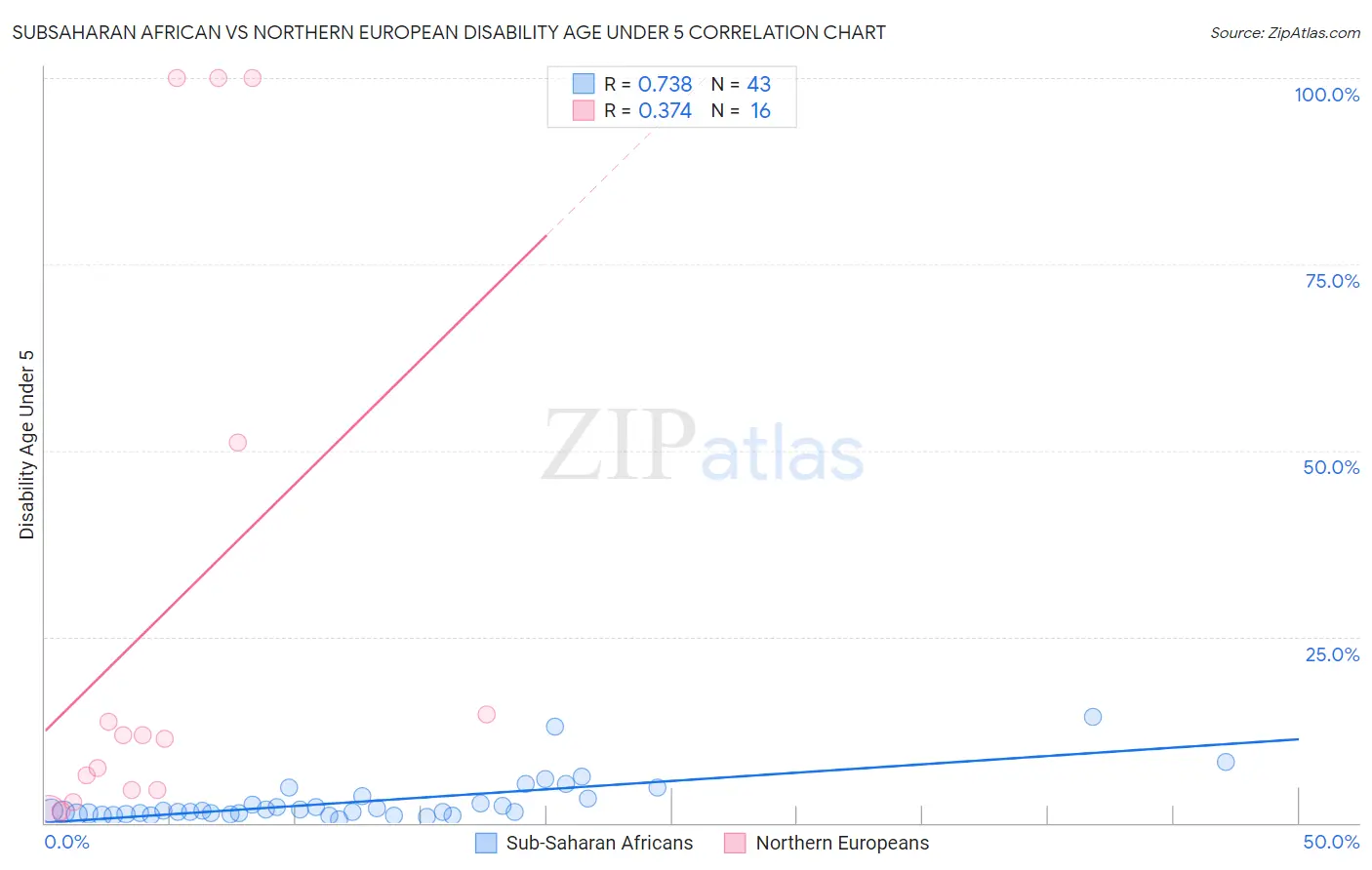Subsaharan African vs Northern European Disability Age Under 5
COMPARE
Subsaharan African
Northern European
Disability Age Under 5
Disability Age Under 5 Comparison
Sub-Saharan Africans
Northern Europeans
1.3%
DISABILITY AGE UNDER 5
8.3/ 100
METRIC RATING
221st/ 347
METRIC RANK
1.6%
DISABILITY AGE UNDER 5
0.0/ 100
METRIC RATING
291st/ 347
METRIC RANK
Subsaharan African vs Northern European Disability Age Under 5 Correlation Chart
The statistical analysis conducted on geographies consisting of 252,320,472 people shows a strong positive correlation between the proportion of Sub-Saharan Africans and percentage of population with a disability under the age of 5 in the United States with a correlation coefficient (R) of 0.738 and weighted average of 1.3%. Similarly, the statistical analysis conducted on geographies consisting of 214,960,262 people shows a mild positive correlation between the proportion of Northern Europeans and percentage of population with a disability under the age of 5 in the United States with a correlation coefficient (R) of 0.374 and weighted average of 1.6%, a difference of 18.7%.

Disability Age Under 5 Correlation Summary
| Measurement | Subsaharan African | Northern European |
| Minimum | 0.47% | 1.2% |
| Maximum | 14.3% | 100.0% |
| Range | 13.8% | 98.8% |
| Mean | 2.8% | 27.6% |
| Median | 1.6% | 11.5% |
| Interquartile 25% (IQ1) | 1.2% | 4.4% |
| Interquartile 75% (IQ3) | 3.4% | 32.8% |
| Interquartile Range (IQR) | 2.1% | 28.4% |
| Standard Deviation (Sample) | 3.0% | 37.7% |
| Standard Deviation (Population) | 2.9% | 36.5% |
Similar Demographics by Disability Age Under 5
Demographics Similar to Sub-Saharan Africans by Disability Age Under 5
In terms of disability age under 5, the demographic groups most similar to Sub-Saharan Africans are Ukrainian (1.3%, a difference of 0.0%), Hispanic or Latino (1.3%, a difference of 0.19%), Serbian (1.3%, a difference of 0.34%), Latvian (1.3%, a difference of 0.35%), and Panamanian (1.3%, a difference of 0.38%).
| Demographics | Rating | Rank | Disability Age Under 5 |
| Immigrants | Chile | 17.2 /100 | #214 | Poor 1.3% |
| Syrians | 16.1 /100 | #215 | Poor 1.3% |
| Bangladeshis | 15.5 /100 | #216 | Poor 1.3% |
| Cypriots | 14.9 /100 | #217 | Poor 1.3% |
| Malaysians | 13.2 /100 | #218 | Poor 1.3% |
| Immigrants | Croatia | 11.2 /100 | #219 | Poor 1.3% |
| Serbians | 9.6 /100 | #220 | Tragic 1.3% |
| Sub-Saharan Africans | 8.3 /100 | #221 | Tragic 1.3% |
| Ukrainians | 8.3 /100 | #222 | Tragic 1.3% |
| Hispanics or Latinos | 7.7 /100 | #223 | Tragic 1.3% |
| Latvians | 7.1 /100 | #224 | Tragic 1.3% |
| Panamanians | 7.1 /100 | #225 | Tragic 1.3% |
| Bahamians | 7.1 /100 | #226 | Tragic 1.3% |
| Taiwanese | 6.1 /100 | #227 | Tragic 1.3% |
| Luxembourgers | 6.1 /100 | #228 | Tragic 1.3% |
Demographics Similar to Northern Europeans by Disability Age Under 5
In terms of disability age under 5, the demographic groups most similar to Northern Europeans are Czech (1.5%, a difference of 0.10%), Italian (1.6%, a difference of 0.14%), Hungarian (1.5%, a difference of 0.22%), Estonian (1.5%, a difference of 0.36%), and Scandinavian (1.5%, a difference of 0.54%).
| Demographics | Rating | Rank | Disability Age Under 5 |
| Europeans | 0.0 /100 | #284 | Tragic 1.5% |
| Croatians | 0.0 /100 | #285 | Tragic 1.5% |
| Tlingit-Haida | 0.0 /100 | #286 | Tragic 1.5% |
| Scandinavians | 0.0 /100 | #287 | Tragic 1.5% |
| Estonians | 0.0 /100 | #288 | Tragic 1.5% |
| Hungarians | 0.0 /100 | #289 | Tragic 1.5% |
| Czechs | 0.0 /100 | #290 | Tragic 1.5% |
| Northern Europeans | 0.0 /100 | #291 | Tragic 1.6% |
| Italians | 0.0 /100 | #292 | Tragic 1.6% |
| Lithuanians | 0.0 /100 | #293 | Tragic 1.6% |
| Swedes | 0.0 /100 | #294 | Tragic 1.6% |
| Finns | 0.0 /100 | #295 | Tragic 1.6% |
| Poles | 0.0 /100 | #296 | Tragic 1.6% |
| Immigrants | Nonimmigrants | 0.0 /100 | #297 | Tragic 1.6% |
| Cajuns | 0.0 /100 | #298 | Tragic 1.6% |